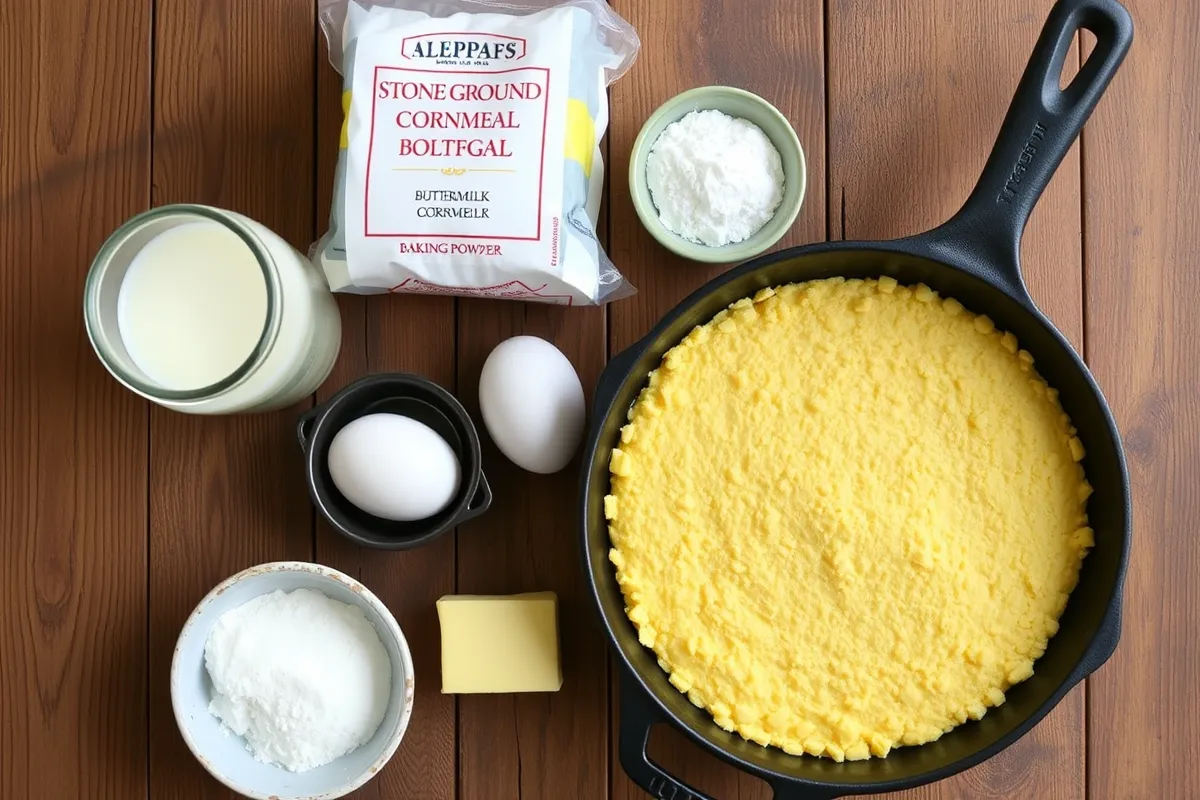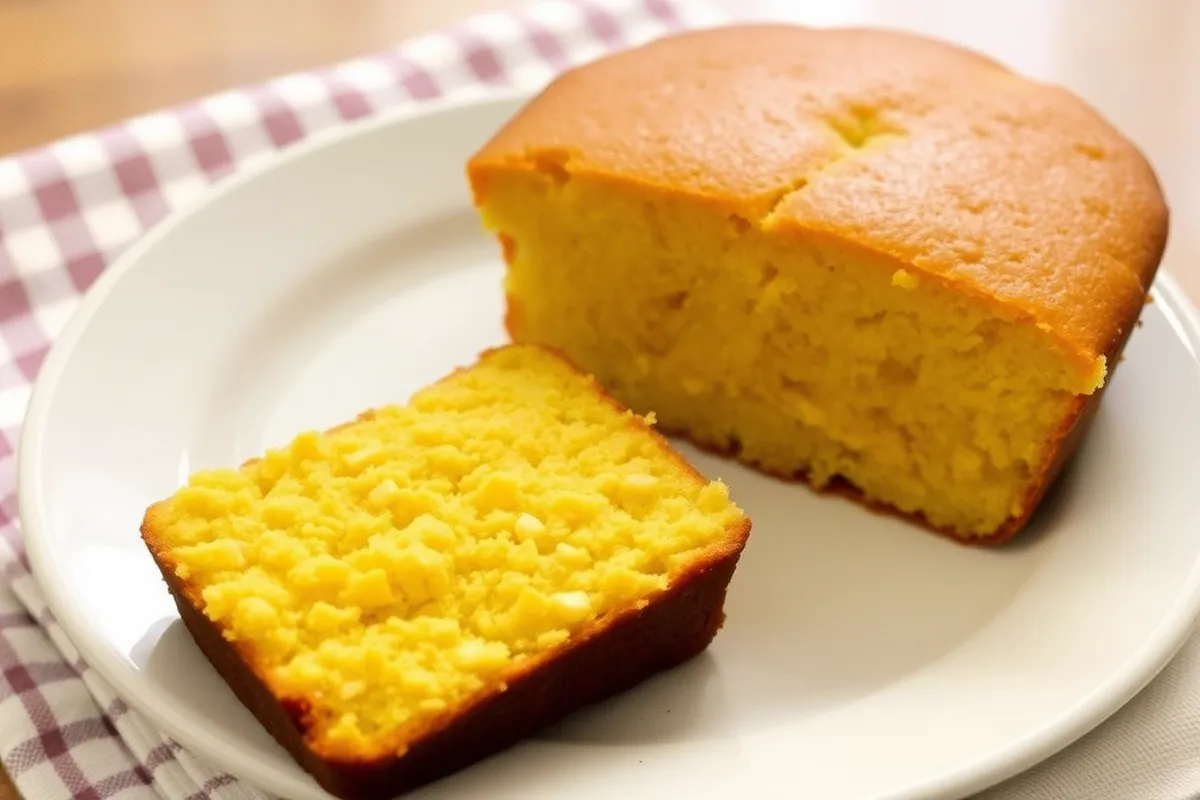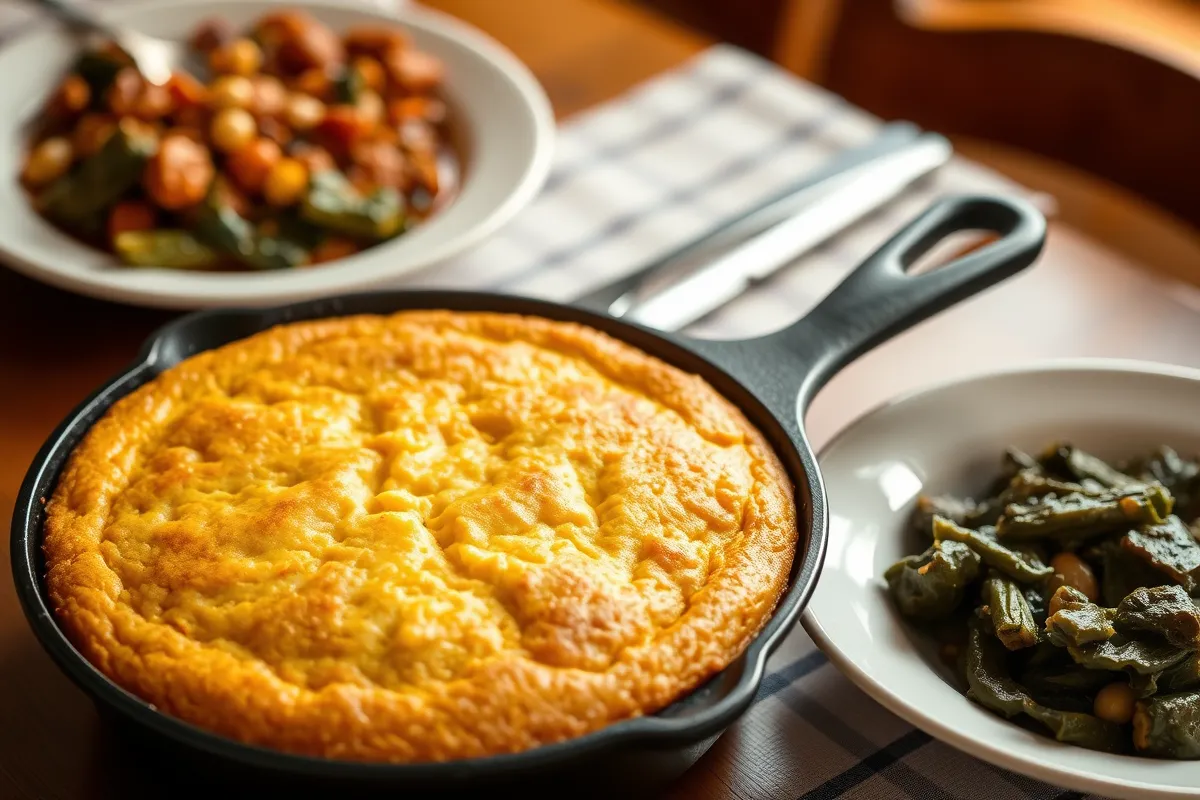Introduction
Southern cornbread is more than just a dish; it’s a cultural experience that tells the story of tradition, family, and community in the Southern United States. This golden delight boasts a crispy crust and a moist, crumbly interior that pairs beautifully with so many classic dishes. In this article, you’ll learn everything about making authentic Southern cornbread—its rich history, essential ingredients, techniques, and even troubleshooting tips. Whether you’re new to Southern cooking or just refining your recipe, you’re in for a treat!
Southern Cornbread Recipe
The Origins of Southern Cornbread
Native American Influence
Before cornbread graced Southern tables, Native Americans were already making bread from ground corn, which they called “ash cakes.” They would bake this simple yet nutritious bread directly on heated stones or ashes, giving it a unique flavor. These early techniques laid the foundation for what we now know as Southern cornbread. The transition from ash cakes to oven-baked bread represents a merging of Native culinary traditions with European settlers’ influences.
Evolution Through the Colonial Era
When colonists settled in the South, corn became a crucial staple due to its resilience in the region’s warm climate. Flour was scarce, so cornmeal often substituted for wheat. Over time, cornbread recipes evolved, incorporating local ingredients and cooking methods. This evolution gave us the distinct, savory version loved by Southerners today. Unlike its sweeter Northern cousin, traditional Southern cornbread remains simple and hearty, made with few ingredients but full of character.
Did You Know? During the Civil War, cornbread was a lifesaver for many families, as it was cheap and filling. Today, its legacy lives on as an essential part of Southern cuisine.
History and Cultural Significance
The Origins of Southern Cornbread
Native American Influence
Long before the advent of modern cornbread, Native Americans utilized corn as a dietary cornerstone. They ground it into a coarse meal to create simple, hearty breads like “ash cakes,” cooked directly on hot stones or over open flames. These methods emphasized practicality and flavor, making corn a versatile and essential ingredient in their cuisine. This ingenious use of cornmeal was later adopted and adapted by European settlers, blending cultures in ways that are still celebrated today.
Evolution Through the Colonial Era
Cornbread’s transformation into a Southern staple began during the colonial period. European settlers introduced ovens and baking techniques, creating recipes that combined cornmeal with buttermilk and fats for richness. Unlike wheat, which struggled in the Southern climate, corn thrived. This adaptability ensured its prominence in regional cooking. Over time, the dish evolved from basic sustenance to a beloved cultural icon, with families crafting unique recipes reflecting local flavors and traditions.
Cultural Importance in the Southern United States
Cornbread in Southern Traditions
Cornbread holds a cherished spot on the Southern table, symbolizing comfort and community. Whether paired with collard greens at Sunday dinner or served as a side during holiday feasts, it bridges generations. For many families, the act of making cornbread is steeped in ritual—preheating the skillet, whisking the batter, and savoring the aroma as it bakes. Its presence at gatherings reflects the Southern values of hospitality and tradition.
Variations Across the Southern States
Despite its simplicity, Southern cornbread showcases regional differences. In some areas, sugar is a contentious addition, with purists insisting on a savory profile. Elsewhere, recipes include mix-ins like jalapeños, cheddar cheese, or even whole kernels of corn. These regional adaptations reflect the creativity and resourcefulness of Southern cooks, who tailor cornbread to suit local ingredients and personal tastes.
Ingredients and Their Roles

Essential Ingredients for Authentic Southern Cornbread
Cornmeal
The heart of any Southern cornbread recipe is stone-ground cornmeal, prized for its coarse texture and robust flavor. Unlike finely milled cornmeal, stone-ground varieties retain more of the germ and bran, giving cornbread its characteristic nutty taste and slightly crumbly texture. Choosing high-quality, fresh cornmeal is key—it ensures a richer flavor and better consistency.
Buttermilk
Buttermilk plays a dual role in Southern cornbread, providing both moisture and tang. The acidity of buttermilk reacts with baking soda, creating carbon dioxide bubbles that help the cornbread rise, resulting in a tender crumb. It also imparts a subtle sour note that complements the earthiness of the cornmeal. If buttermilk isn’t on hand, a mix of milk and lemon juice can be used as a substitute.
Leavening Agents
To achieve the perfect rise, traditional recipes rely on baking powder or a combination of baking powder and baking soda. These leavening agents ensure the cornbread is light and fluffy without compromising its dense, hearty quality. Precise measurement is vital—too much or too little can drastically alter the texture.
Fats
Fats like butter or oil enrich the cornbread and keep it moist. Many Southern cooks swear by melted butter for its rich, creamy flavor, while others prefer vegetable oil for a more neutral taste. Regardless of preference, fats are integral to balancing the dryness of cornmeal and creating a tender crumb.
Optional Additions and Variations
Sweeteners
The debate over whether or not to add sugar to Southern cornbread is as old as the recipe itself. Traditionalists argue that authentic cornbread should remain savory, while others prefer a touch of sweetness to round out the flavors. A small amount of sugar—or even honey—can enhance the natural sweetness of the cornmeal without overshadowing its flavor.
Additional Mix-ins
Southern cornbread is remarkably versatile, and cooks often personalize their recipes with creative additions. Popular mix-ins include diced jalapeños for heat, shredded cheddar cheese for a gooey texture, and whole corn kernels for bursts of sweetness. These extras not only add depth but also make the cornbread a stand-alone dish rather than just a side.
Equipment and Preparation Techniques
Choosing the Right Equipment
Importance of a Cast-Iron Skillet
When it comes to Southern cornbread, a cast-iron skillet is more than just a baking tool—it’s an essential element of the recipe. The heavy material retains heat evenly, creating that signature crispy, golden crust while keeping the interior moist and tender. Preheating the skillet before adding the batter ensures the cornbread develops a satisfying crunch. Plus, there’s something undeniably nostalgic about serving cornbread directly from the skillet, making it both functional and authentic.
Alternative Baking Vessels
Although cast iron is preferred, other options can still yield excellent results. Oven-safe glass or ceramic dishes can be used if you don’t have a cast-iron skillet. These alternatives may not produce as crispy a crust, but they’re effective for achieving a soft, even bake. If you’re in a pinch, a metal cake pan can also work—just be sure to grease it well to prevent sticking.
Step-by-Step Preparation Guide Of Southern Cornbread
Preheating the Skillet
The key to a perfect crust lies in preheating your skillet. Place it in the oven while it heats up, allowing the pan to become piping hot. Once the batter hits the hot skillet, it creates an immediate sizzle, which is crucial for forming a crispy exterior. Don’t skip this step—it’s what sets Southern cornbread apart from other styles.
Mixing the Batter
When mixing the batter, less is more. Combine your stone-ground cornmeal, buttermilk, eggs, and leavening agents gently to avoid overmixing. Overworking the batter can result in dense, tough cornbread, so aim for a consistency that’s smooth yet slightly lumpy.
Baking and Testing for Doneness
Pour the batter into the preheated skillet and return it to the oven. Bake at 375°F to 400°F until the edges pull away from the sides, and the top turns golden brown. To test for doneness, insert a toothpick or knife into the center—it should come out clean. Let the cornbread rest for a few minutes before serving to lock in moisture and make slicing easier.
Serving Suggestions and Pairings
Traditional Accompaniments
Classic Southern Dishes
Southern cornbread shines brightest when served alongside traditional dishes that complement its hearty flavor and crumbly texture. Pair it with collard greens simmered with onions and garlic for a classic combination, or serve it alongside slow-cooked beans to soak up the flavorful broth. For something heartier, try pairing cornbread with fried chicken or a steaming bowl of chili—its subtle corn flavor balances the richness of these dishes perfectly.
Comfort Food Favorites
Cornbread is a natural fit for comfort foods. Serve it with a ladle of homemade chicken soup or as a base for turkey gravy during the holidays. Its versatility allows it to act as both a side dish and an ingredient in main courses.
Modern Twists and Creative Uses

Cornbread Stuffing and Croutons
Leftover cornbread can easily transform into a new dish. Crumble it up and use it as a base for stuffing, adding herbs, celery, and onions for a savory twist. Alternatively, cut the cornbread into cubes, toast them in the oven, and use them as croutons for salads or soups. These innovative uses breathe new life into leftover portions.
Layered Cornbread Casseroles
For a modern twist, layer cornbread with seasoned ground beef, vegetables, and cheese to create a cornbread casserole. This creative take turns a simple recipe into a complete meal, showcasing how versatile Southern cornbread can be.
Cornbread isn’t just a side; it’s a canvas for creativity and tradition, making it a beloved staple in Southern homes.
Common Mistakes and Troubleshooting
Avoiding Common Pitfalls
Preventing a Dry Texture
One of the most common issues with Southern cornbread is dryness, but it’s easily avoidable with the right techniques. First, ensure you’re using buttermilk or a suitable substitute to add moisture. Overbaking is another culprit—always keep an eye on your cornbread, as even a few extra minutes in the oven can rob it of its tender crumb. Finally, resist the urge to cut into it immediately after baking; letting it rest allows the steam to redistribute, ensuring a moist texture.
Achieving the Perfect Crust
The crispy, golden crust is a hallmark of authentic Southern cornbread, and achieving it requires a preheated cast-iron skillet. Without this step, the crust might turn out too soft or unevenly browned. Additionally, using enough fat—whether butter or oil—in the skillet before pouring in the batter is essential. The sizzling reaction as the batter hits the hot pan is what creates that crunchy edge. Don’t skimp on this step!
Tips for Consistent Results
- Always use fresh stone-ground cornmeal, as stale or old cornmeal can produce a bland or crumbly result.
- Measure your ingredients carefully—cornbread relies on balance, and too much or too little of a single ingredient can alter its texture and flavor.
- If your cornbread crumbles too much, it’s often a sign of insufficient moisture or a lack of binding agents like eggs. Adjust accordingly for the next batch.
- Avoid overmixing the batter, as this can lead to a dense, heavy texture. Aim for a mix that’s combined but still slightly lumpy for the best results.
With these troubleshooting tips, you’ll not only fix any potential mishaps but also ensure every cornbread batch is a delicious success.
Frequently Asked Questions (Southern Cornbread)
Is sugar traditionally added to Southern cornbread?
This is a hotly debated topic! Traditionally, Southern cornbread is savory, with no sugar added. The absence of sweetness sets it apart from its Northern counterpart, which often includes sugar for a sweeter profile. However, some modern variations incorporate a small amount of sugar or honey for balance. Ultimately, it comes down to personal preference and regional tradition.
Can I use regular milk instead of buttermilk?
While buttermilk is ideal for its tangy flavor and reaction with leavening agents, regular milk can work in a pinch. For a closer approximation, add a tablespoon of lemon juice or vinegar to one cup of milk and let it sit for 5–10 minutes. This creates a buttermilk substitute that adds the acidity needed for a tender, flavorful cornbread.
How do I store and reheat leftover cornbread?
Store leftover cornbread in an airtight container at room temperature for up to two days. For longer storage, refrigerate it for up to a week or freeze it for up to three months. To reheat, wrap the cornbread in foil and place it in a 350°F oven for about 10 minutes. This method helps preserve its texture and flavor.
What can I substitute for a cast-iron skillet?
If a cast-iron skillet isn’t available, oven-safe glass, ceramic dishes, or metal cake pans can be used instead. These alternatives may not produce the same crispy crust but will still yield a delicious result. Make sure to preheat the dish and grease it thoroughly to mimic the skillet’s effect.
How can I make gluten-free Southern cornbread?
Cornmeal itself is naturally gluten-free, so adapting a cornbread recipe is simple. Substitute all-purpose flour with gluten-free flour or use a recipe that omits flour altogether. Check that your baking powder and other ingredients are certified gluten-free for a completely safe dish.
Why is my cornbread crumbly, and how can I fix it?
Excess crumbliness is often caused by a lack of moisture or insufficient binding agents. Ensure you’re using enough fat (like butter or oil) and eggs to hold the batter together. Adding a small amount of sour cream or yogurt can also improve texture and reduce crumbliness.
Conclusion
Embracing the Tradition of Southern Cornbread
Southern cornbread isn’t just a recipe—it’s a symbol of heritage, community, and culinary creativity. From its origins with Native Americans to its evolution as a Southern staple, this dish tells a story that’s as rich and flavorful as the cornbread itself.
By mastering the essential ingredients, using the right equipment like a cast-iron skillet, and following time-honored preparation techniques, you can create an authentic version of this beloved classic. Whether you stick to tradition or add your own twist with mix-ins and modern pairings, Southern cornbread remains one of the most versatile and cherished dishes in Southern cuisine.
So, gather your ingredients, preheat that skillet, and get ready to enjoy the crispy crust and moist interior that make Southern cornbread truly unforgettable. With the knowledge and tips shared in this guide, you’re well on your way to crafting a dish that’s sure to become a family favorite.

